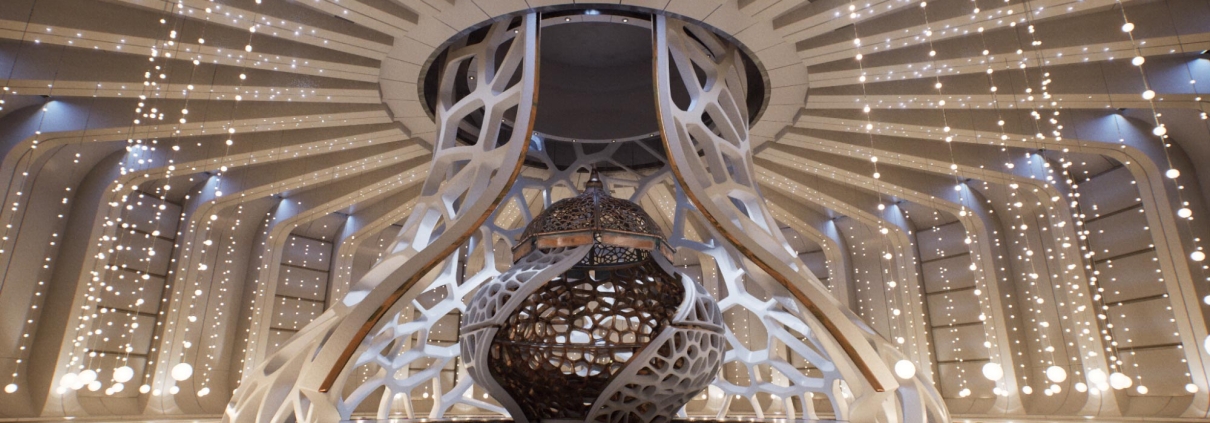Unreal Engine Megalights: A Breakthrough in Real-Time Architecture
At Moøkan, we are constantly seeking ways to push the boundaries of realism and performance in virtual experiences. Our latest advancement embraces Unreal Engine Megalights, a cutting-edge technology that allows us to achieve a new level of dynamic lighting — in real time, and without compromise.
This evolution marks a turning point in how architectural and design projects are simulated, offering our clients unprecedented realism, flexibility, and speed across a wide range of industries.
A New Era of Real-Time Lighting
Until recently, achieving realistic dynamic lighting required significant hardware power, especially in VR environments where maintaining high frame rates is essential. Architectural visualizations, in particular, involve dozens or even hundreds of real-world light sources. Accurately replicating them often meant using IES light profiles provided by manufacturers to match the final lighting installation.
Traditional solutions, like NVIDIA Ray Tracing and Unreal Engine Lumen, helped bring more accurate lighting to real-time engines. However, they often required trade-offs between visual fidelity and performance, particularly in environments where hardware limitations — such as standalone VR headsets — demanded optimization.
Today, with the introduction of Megalights, that balance shifts decisively. We can now simulate hundreds of active, shadow-casting light sources with minimal impact on performance. This not only allows more faithful architectural representations but also enables dynamic interactivity, giving our clients a more authentic experience of their spaces.
Dynamic Flexibility Without the Overhead
One of the most transformative aspects of adopting Megalights is the design freedom it offers. Instead of predefining a handful of fixed lighting scenarios, we can now offer fully dynamic lighting simulations, allowing users to:
- Dim lights in real time
- Switch between different lighting moods or configurations
- Experience how a space evolves from day to night
- Explore emergency lighting plans or energy-saving schemes
This dynamic flexibility accelerates the design and review process. Changes that once required hours of re-baking static lighting — involving heavy computation and long waits — now happen instantly. As a result, iteration cycles become faster, approvals are quicker, and design teams can explore more possibilities without being slowed down by technical limitations.
Moreover, the abandonment of static lighting data leads to a dramatic reduction in project file sizes. Large-scale scenes that previously consumed 5 GB or more are now efficiently compressed into files as small as 1 GB. This reduction improves transfer speeds, makes remote collaboration more effective, and ensures that even complex projects remain agile and responsive throughout development.
Bringing Greater Realism to Virtual Reality
For VR experiences, where smooth performance and realism are both critical, the impact of Megalights is even more pronounced. Being able to simulate complex lighting — from the soft glow of sconces in a luxury hotel corridor to the dramatic stage lighting of an arena — brings a level of immersion that was previously difficult to achieve without powerful PCs tethered to headsets.
With Megalights, we can now deliver this quality even on lighter, wireless VR platforms, expanding access and ensuring that all stakeholders — wherever they are — can step into the design and truly feel it.
This is particularly powerful for industries like hospitality, cultural institutions, and retail, where atmosphere and emotional impact are key success factors.
Enhancing Client Communication and Decision-Making
Beyond technical advances, the real value lies in how Megalights transform the way clients interact with their projects.
With more realistic, dynamic environments, decision-makers are better equipped to evaluate not just the look of a design but how it feels across different scenarios. Lighting studies become more intuitive. Material choices can be judged not only under ideal conditions but also in real-world complexities — dimmed evening receptions, natural daylight spilling through windows, focused spotlighting for art collections.
This depth of insight leads to better, more confident decisions early in the process, reducing costly changes later and ensuring that the built result closely matches the original vision.
It also improves communication across large project teams, providing a shared visual language where subjective descriptions are replaced with tangible, navigable experiences.
A New Standard for Architectural Visualization
As we look ahead, we believe that Megalights — and real-time dynamic lighting in general — will become a new standard for professional architectural and spatial visualization.
Static renders will always have a role, but the ability to interactively experience complex environments, explore lighting design options, and simulate real-world conditions offers a depth of engagement that traditional methods simply cannot match.
At Moøkan, we are committed to leading this evolution. We have integrated Megalights fully into our workflows for architecture, luxury hotel development, public space design, retail experiences, and beyond.
By offering the latest technology with a focus on creativity, precision, and usability, we ensure that our clients are not only keeping up with industry trends but staying ahead of them.
Building Better Futures, One Light at a Time
Our mission has always been to bridge imagination and reality through the most advanced immersive tools. With Unreal Engine Megalights, we take another decisive step forward.
We invite our partners and clients to experience firsthand how dynamic real-time lighting can enhance their projects — making designs more vivid, reviews more effective, and visions more achievable.
At Moøkan, we don’t just visualize the future.
We help build it — one light, one detail, one immersive experience at a time.

 Image courtesy of Epic Games / Unreal Engine.
Image courtesy of Epic Games / Unreal Engine.

 Image courtesy of Top Builders Group.
Image courtesy of Top Builders Group.